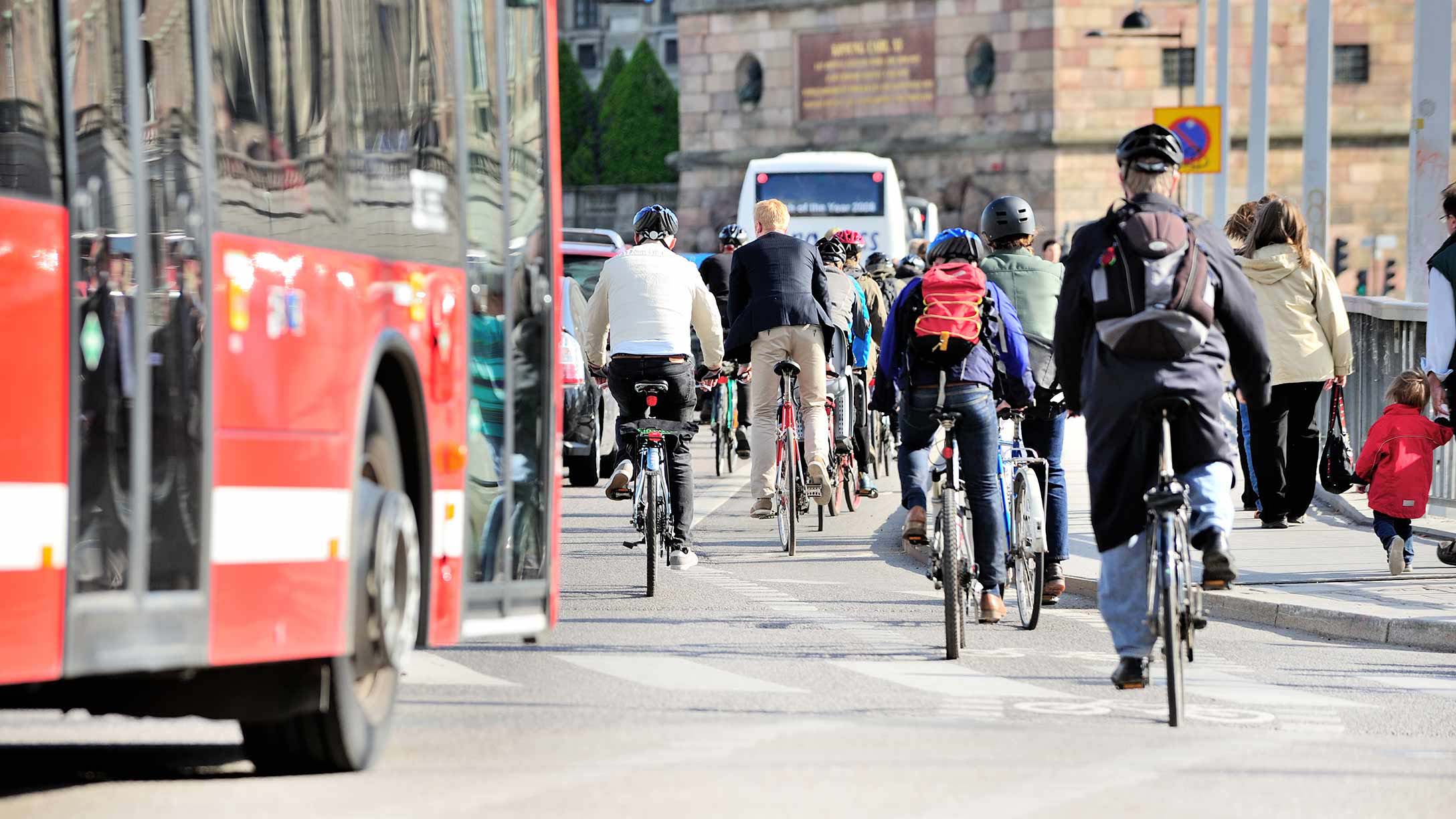What is mobility as a service?
What is Mobility as a Service?
By Geotab Team
Aug 21, 2024

By 2030, less than one-quarter of Americans will own a car. Self-driving cars are rolling out, car sharing is gaining acceptance and people are looking for greener options. What does the future of transportation look like? The answer lies in the concept of Mobility as a Service.
See also: Key findings from the Industry Pulse Analysis on Fleet, Mobility and Transportation recovery
What is Mobility as a Service (MaaS)?
Mobility as a Service, also known as MaaS and sometimes referred to as Transportation as a Service (TaaS), is a consumer-centric model of people transportation. MaaS is an on-demand, real-time platform that can include any combination of transport methods such as car and bike sharing, taxis and car rentals/leases, and provides everything for the consumer from travel planning to payments.
Subscribe to an app and you could have access to a scooter, bike, car or a train pass, for however long you need it. The end result is a more convenient and affordable method of getting around.
Another term often used interchangeably is smart mobility — a wider concept involving various modes of transportation for ecological and social benefit. Smart cities incorporate smart mobility as a part of the solution to reduce traffic congestion and increase efficiency. Smarter, cleaner vehicles will help lower emissions and increase road safety. We explain smart mobility in more detail in this article.
See also: Micromobility and the changing transportation landscape
What are the benefits of Mobility as a Service?
The benefits of MaaS include:
- Easy route planning — Real-time route planning allows users to plan journeys using multiple transport methods, based on intelligent suggestions derived from their personal preferences.
- Simplified payments — MaaS users can pay for transportation using phones, smartwatches and bank cards, before or after their journey, or on a subscription basis.
- The personal touch — MaaS is a fully personalized service that builds relationships between users and the transport provider. By using big data, two-way communication and constant user feedback, MaaS systems become the ultimate customer-focused transportation platforms.
Mobility as a Service examples
One model used by transportation providers is Peer-to-Peer ride-sharing. This is when drivers use their own vehicles to provide a service to registered users via an app. Another comes in the form of peer-to peer rentals where an owner rents out their vehicle.
There’s also commercial and public ride sharing platforms as well involving various modes of transport. Each transport option can be integrated into one digital mobile app that covers the process from start to finish, including but not limited to booking, trip planning, and electronic payment.
Here are some examples of MaaS platforms:
Uber is a peer-to-peer transportation provider that is branching out into short-term car rental and public transit ticket purchasing. The company has expanded to more than 800 cities and 80 countries since its inception. Whereas Lyft is in over 300 cities and servicing over one million rides per day. Turo, which has been called the “Airbnb of cars,” is a peer-to-peer rental company that enables private owners to rent out their cars to others. The company recently partnered with Porsche to launch a pilot program in San Francisco and Los Angeles that allows drivers to rent one of the sports cars for several hundred dollars a day.
GM also joined in with its AirBnB for cars launch of Maven. It’s a step toward the transition from auto manufacturer to mobility provider.
The Whim app, owned by MaaS Global of Helsinki, Finland, is available for monthly fee plans or pay-as-you-go. Travelers can use the platform to plan and pay for all modes of public and private transportation within Helsinki, including trains, taxis (short runs), buses, car shares and bike shares. Whim users simply enter a destination, select their preferred mode of transport, which can include single or multiple modes, and go.
WienMobil in Austria will plan an intermodal route for a user based of the optimal mix of transport methods — including walking.
Mobilleo offers a MaaS for business solution, also including hotel, expense tracking and concierge service.
The newest platforms of MaaS are third-party aggregators which Uber could partially be considered as yet it involves the kind of integration that brings all of these platforms together in one user-friendly space. As an emerging platform, it’s complex. Delivering a service spanning various modes of transport, both public and private, involves pricing dependencies that impact user experience. Physical integrations are needed as well. For example, should the best route include two modes of transportation physical infrastructure would need to be in place for seamless transfer.
Geotab also offers free aggregated data for smart cities and businesses at data.geotab.com. Read: Everything You Need to Know About data.geotab.com
MaaS and the future of transportation
In ten years’ time, MaaS is predicted to be worth a staggering $1.76 trillion, a quarter of the entire transportation industry, and to have completely revolutionized how we all live and work.
With more people and less space for cars in cities, one natural solution is to share the few cars we have space for. With the help of MaaS, people are already stepping away from their own cars and into someone else's, taking advantage of the benefits that shared mobility offers without the hassle of driving, parking or maintaining a car.
The end of the privately-owned car?
Ride-sharing is still on the rise. By 2024, ride-sharing apps are set to boast over 23 million members, up from less than 2 million in 2012. During 2017, Lyft completed 375.5 million journeys in just the United States and Toronto, with the number of year-on-year unique passengers leaping from 12 million to 23 million. Meanwhile, Uber oversaw 4 billion global journeys in the same timeframe.
The success of Whim in Helsinki has shown that MaaS does work, and higlights what it can do on a larger scale for the world’s greater urban hubs. Paris, Eindhoven, Gothenburg, Montpellier, Vienna, Hanover, Las Vegas, Los Angeles, Denver, Singapore, and Barcelona are all trailing their own MaaS systems that include everything from peer-to-peer and integrated public transportation, to combined mobility services that include private-sector companies.
The end goal of Whim is to make it unnecessary for any city resident to own a private car by 2025. It’s an almost unthinkable concept in an economy still built around private car ownership, but Helsinki residents are quickly finding that the benefits of using a MaaS system actually outweigh those of owning a private car. They’re not being forced to give up their cars. Nor are they penalized for having one. The alternative is simply more appealing.
Conclusion
By the middle of the century, the UN estimates that 66% of us will be living in urban areas, up from just 30% in 1970. With such a radical change taking place regarding the world population’s living habits, fundamental changes are also needed in the way we live and get around in bigger, denser urban areas, and these changes will certainly involve MaaS.
Continue the conversation on mobility and the future of fleet. Visit the Geotab MOBILITY CONNECT website and sign up for digital content from our next event in Barcelona.
Related:
Urban traffic congestion: New laws and how to prepare
Subscribe to get industry tips and insights
The Geotab Team write about company news.
Table of Contents
Subscribe to get industry tips and insights
Related posts

Collision avoidance systems: How fleets prevent incidents and improve safety
December 23, 2025
5 minute read

The $4B Crisis: Video Intelligence as the Answer to Fleet Distraction
December 2, 2025
3 minute read

The True Cost of Cargo Theft: When Customer Trust is on the Line
November 24, 2025
2 minute read

Telematics device cost: Key factors that determine pricing
November 19, 2025
5 minute read

Law enforcement technology: Four trends to know for 2026
November 7, 2025
6 minute read

Four seasons of fleet intelligence with Geotab's Public Works solution
November 7, 2025
2 minute read